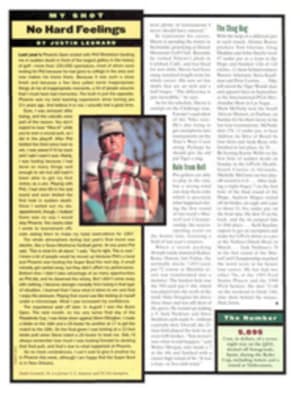
THE SNOW KING FOR 20 YEARS DAVE LACOMBE HAS BEEN BLANKETING THE SLOPES AT KILLINGTON, VT.
Last winter, Vermont's Killington ski mountain resort ran a
two-page magazine advertisement picturing slopes and trees under
a prodigious dumping of snow. "Was it God," the caption asked,
"or was it Dave Lacombe?" A framed copy of the ad hangs over a
filing cabinet in Lacombe's cluttered Killington office. A
waggish colleague affixed a yellow Post-it note inscribed with a
message from God: "David, Finally somebody recognizes our
talents."
At 36, Lacombe is snowmaking's master blaster. Killington, the
biggest ski resort in the East, relies on him to whiten 552
acres of trails from October to April and to keep them blanketed
throughout the balmy interludes imposed by Vermont's fickle
climate. "Snowmaking is our lifeblood," says Killington
president Allen Wilson. "Without Lacombe, we'd be out of
business."
Last year, according to Snow Country magazine, Killington was
the top snow producer in the East. Like its competitors,
Killington employs every possible marketing tool to lure patrons
onto its lifts. Every major ski area has snowmaking equipment
and crews, but no one covers as big an area for as long a season
as Lacombe does. With his work shirt, down vest and droll
delivery, the foremost professor of snowflakes could be comedian
Tim Allen's younger brother. He is a 20-year veteran of his
craft, having joined Killington's night shift in 1977 as a high
school senior. "I wasn't good for much in class the next
morning," he says. He learned instead the alchemy of snowmaking,
and after graduating from high school, he stayed on at
Killington and eventually worked his way up to the top job. In
those backward days, he and his colleagues sprayed the slopes
using cumbersome black rubber hoses. The best they could do was
to cover bald spots with a granular substance that skiers call
crud.
Today Lacombe applies silky layers of man-made snow that are
almost indistinguishable from natural snow. His expertise has
earned him the nickname Mother Nature. He has been recruited to
make snow for winter carnivals at Dartmouth College, the Vermont
state capitol grounds and New York City's Central Park. "There's
no magic involved," he says. "You can make snow on your back
porch with a plant mister if it's cold enough."
For 35 consecutive years Killington has opened before its East
Coast rivals. "That's a reputation you don't want to
relinquish," Lacombe says. "I start worrying about it in August.
I don't sleep the night before we start up. Too many things can
go wrong." He extended the streak last fall by producing enough
snow to open Cascade, Killington's topmost trail, on Oct. 4. A
thousand or so eager beavers showed up over four days for
early-bird skiing even as golfers traversed green fairways
below. The rumor of snow lured one diehard all the way from
Ohio. As always, Lacombe drove his pickup truck up to
congratulate his crew, then skied a few runs on his own. His
critical assessment: The counterfeit snow was as fluffy as
January's finest.
Lacombe's autumn offering signaled the start of New England's
ski season. As usual, the snow melted a few days after
fulfilling its promotional purpose. Three weeks of disconcerting
warmth followed. Finally, on Oct. 30, Lacombe's consulting
meteorologist promised that the mercury would drop the next day.
Lacombe worked the phones in a state of high anticipation. His
band of deputies saw to all the urgent errands--welding pipes,
mustering an arsenal of 55 snow guns, firing up air
compressors--in preparation for a manufactured Halloween
blizzard. They clearly relished the prospect. "We'll be starting
the snow guns with big smiles on our faces," Lacombe said.
"Playing with water in the winter can be brutal. But it's a job
like no other. We get to see the sunrise and the northern
lights. And there's great satisfaction in covering the trails
with rolling carpets of velvety snow."
Lacombe had sketched his battle plan in coded colors on a
topographic map tacked to his wall. He would start at Cascade
and work downward as far as temperatures permitted. By
Thanksgiving the mountain would look like a half-iced cake. By
Christmas, snow would blanket all 177 trails. From then on
Lacombe's army would work around the clock, seven days a week,
continually replenishing the 44 miles of groomed skiing surface.
"Snow gets old," Lacombe says. "It needs to be cultivated, like
a garden."
Lacombe waters his garden with plumbing suited to a city.
Ninety-three miles of pipe and 41 miles of hose supply 11.5
million gallons of water a day to 200 snow guns. In all, he has
900 portable and 500 stationary snow guns he can fire up. The
water is drawn from Killington's own reservoir and pond. The
patented snow guns, which Lacombe helped design, are the Alpine
equivalent of fire hoses; they each blast an average of 50
gallons per minute into 75-foot plumes of flakes. Every two
hours, day and night, workers wearing snowsuits and crampons
nimbly descend steep slopes to reposition the guns. Lacombe
himself is always on call, except when he takes time off to go
ice fishing. "I guess it's an addiction to frozen things," he
says.
All sorts of things can go wrong on the mountain. A burst pipe
can wash the snow off a trail or, worse, a fallen tree can shut
off the power. "Stationary water freezes within minutes,"
Lacombe says. "There's panic on the hill." On these
occasions--the snowmaking equivalent of a code-red crisis--Team
Lacombe scrambles to dig out buried hoses frozen like 50-foot
spaghetti strands and move them to a shed with a heated floor.
It takes 12 hours to thaw the hoses, air-blast them dry and
restore them to the mountain.
Lacombe's hard-wired control room could pass for the north woods
version of the USS Enterprise. Hundreds of colored lights
indicate the status of valves and snow guns. A printer spews
hourly updates on water flow, pump pressure and air temperature
in six locations. Computer monitors offer everything from
three-dimensional schematics of remote pumping stations to lists
of the size and manufactur-er of individual bolts. "The control
room is a very tense place," Lacombe says. "I try to spend as
little time here as possible. My real office is out there."
At least once a day, Lacombe skis the mountain, pausing to
appraise handfuls of snow. In the end, there is no replacement
for the connoisseur's touch. If a snowball turns gray, for
example, he knows his product is too wet. "It's a fine line," he
says. "It should be dry, but not too dry."
Lacombe's long campaign winds down on the cusp of spring. In
early April, about the time ski shops stage liquidation sales,
he commits all his resources to amassing a 30-foot layer of snow
on a single high-altitude slope that can be skied into June.
This mogul-pocked strip of white is usually the last skiable
spot in the East.
"Our final job is to build this god-awful mound," Lacombe says.
"It's so thick that skiers can shake hands with people on the
chairlift. That's our last hurrah before shutting down."
Freelancer Michael Cannell first skied at Killington in 1965,
when he was five years old.
COLOR PHOTO: PHOTOGRAPHS BY HUBERT SCHRIEBL In the middle of a blizzard of his own making, the always-on-call Lacombe checks out a snow gun. [Dave Lacombe near snow machines]
COLOR PHOTO: PHOTOGRAPHS BY HUBERT SCHRIEBL Lacombe is not usually all smiles in the Killington control room.[Dave Lacombe]

